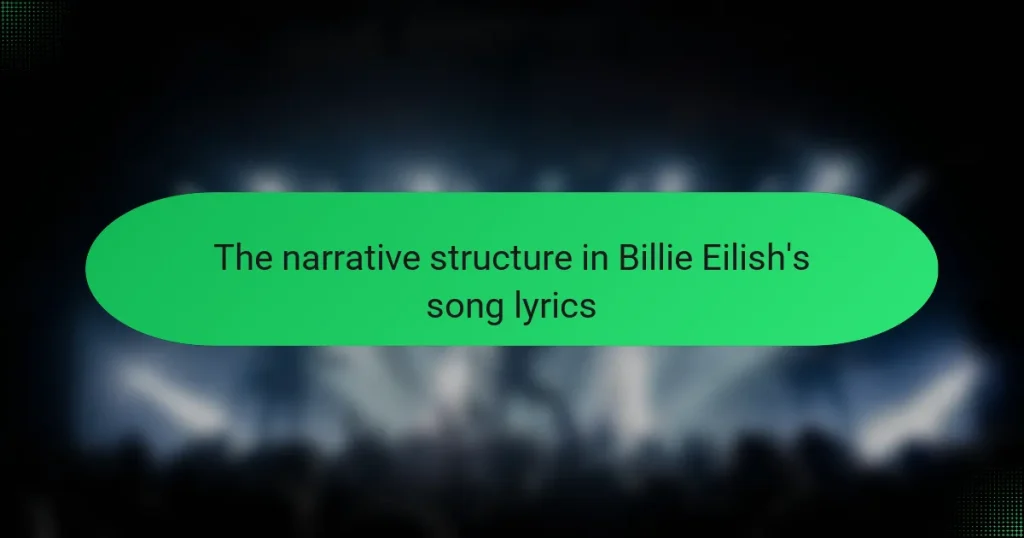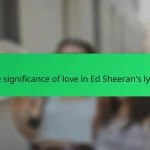Billie Eilish’s song lyrics are characterized by a narrative structure that intricately combines introspection with storytelling. This structure often features a clear protagonist who shares personal struggles, emotional conflicts, and societal issues, allowing for deep listener engagement. Eilish employs vivid imagery, metaphor, and a first-person perspective to enhance the relatability and emotional impact of her narratives. Techniques such as repetition and unresolved tension further contribute to the depth of her storytelling, making her messages resonate widely with audiences. Notable examples, such as “When the Party’s Over,” illustrate how her lyrical progression mirrors a journey of realization and catharsis.
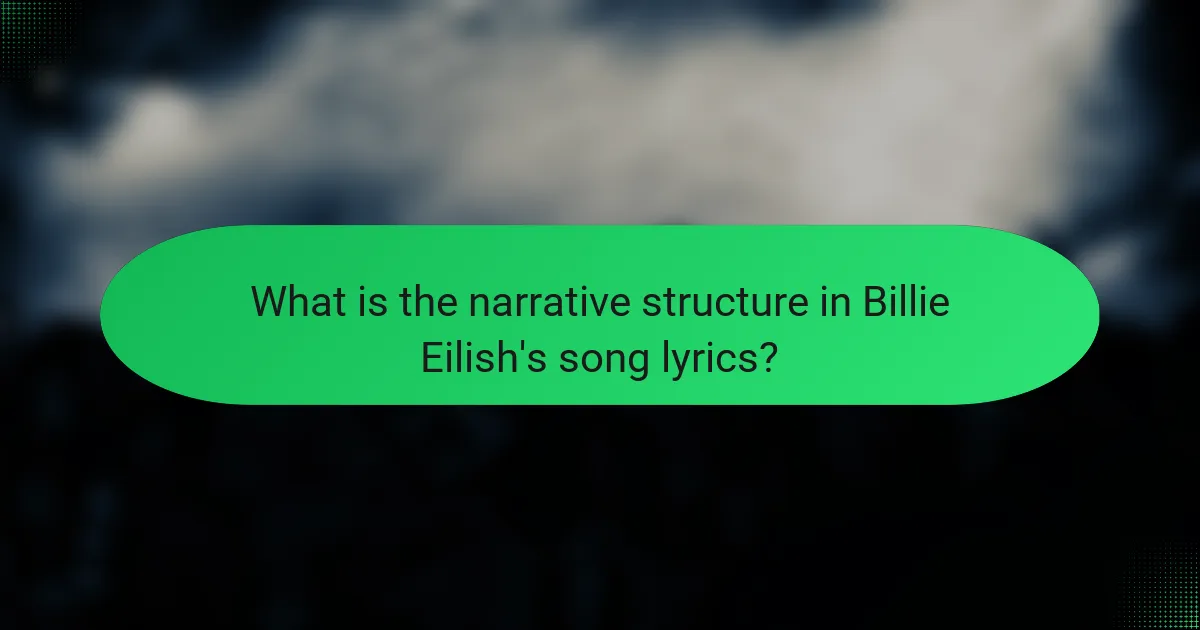
What is the narrative structure in Billie Eilish’s song lyrics?
Billie Eilish’s song lyrics often feature a narrative structure that combines introspection and storytelling. Her lyrics typically explore themes of personal struggle, emotional conflict, and societal issues. Many songs present a clear protagonist who shares their experiences and feelings. This character-driven approach allows listeners to connect deeply with the narrative. Eilish frequently employs vivid imagery and metaphor to enhance the storytelling. The progression of her lyrics often mirrors a journey, leading to moments of realization or catharsis. Specific songs, like “When the Party’s Over,” exemplify this structure through their haunting reflections on heartbreak. Overall, Eilish’s narrative style is marked by authenticity and relatability, engaging audiences on multiple emotional levels.
How does Billie Eilish utilize storytelling in her lyrics?
Billie Eilish utilizes storytelling in her lyrics by creating vivid imagery and relatable narratives. Her songs often feature personal experiences and emotional journeys. Eilish uses first-person perspectives to draw listeners into her world. This technique fosters a strong connection between her and her audience. She incorporates details that evoke specific feelings and situations. For example, in “When the Party’s Over,” she explores themes of heartbreak and vulnerability. Her lyrics often reflect introspection and self-discovery. Eilish’s storytelling is enhanced by her unique vocal delivery and atmospheric production. This combination deepens the emotional impact of her narratives.
What themes are commonly explored in her narratives?
Billie Eilish’s narratives commonly explore themes of mental health, heartbreak, and self-identity. Her lyrics often reflect struggles with anxiety and depression. For instance, songs like “Bellyache” delve into guilt and moral conflict. Additionally, “When the Party’s Over” addresses emotional vulnerability and the pain of separation. Eilish frequently examines the complexities of youth and relationships. Her storytelling captures feelings of isolation and the search for authenticity. These themes resonate widely, showcasing her unique perspective on contemporary issues.
How do her personal experiences influence her storytelling?
Her personal experiences significantly influence her storytelling. Billie Eilish often draws from her life events and emotions in her lyrics. She incorporates themes of anxiety, heartbreak, and self-discovery. These subjects resonate with her audience, creating a deep emotional connection. Eilish’s songwriting reflects her struggles with mental health and relationships. This authenticity adds layers to her narratives. For instance, her song “When the Party’s Over” conveys feelings of vulnerability and isolation, stemming from her own experiences. Such honest representation makes her storytelling relatable and impactful.
What are the key elements of narrative structure in her songs?
The key elements of narrative structure in Billie Eilish’s songs include character development, conflict, and resolution. Character development is often portrayed through personal experiences and emotions. Eilish frequently uses first-person perspective to create intimacy. Conflict arises from internal struggles or external relationships. This tension drives the narrative forward. Resolution often reflects personal growth or acceptance. Her songs frequently feature vivid imagery and metaphorical language. These elements enhance storytelling and engage listeners emotionally. Eilish’s narrative style resonates with themes of vulnerability and authenticity.
How does the use of characters enhance her lyrics?
The use of characters enhances Billie Eilish’s lyrics by adding depth and relatability. Characters create a narrative that engages listeners emotionally. They allow Eilish to explore different perspectives and experiences. This technique helps convey complex emotions and themes. For instance, in “When the Party’s Over,” the character embodies feelings of heartbreak and vulnerability. The specific portrayal of this character resonates with audiences, making the song more impactful. Overall, characters serve as a vehicle for storytelling in her music, enriching the lyrical experience.
What role does setting play in the narratives of her songs?
Setting plays a crucial role in the narratives of Billie Eilish’s songs. It establishes the emotional landscape and context for the stories she tells. For instance, Eilish often uses urban environments, dimly lit rooms, or natural landscapes to evoke specific feelings. These settings enhance the themes of isolation, anxiety, or longing present in her lyrics. The vivid descriptions of places allow listeners to visualize and connect with the emotions conveyed. In songs like “when the party’s over,” the stark contrast between the setting and the emotional turmoil deepens the impact of the narrative. Thus, the setting is integral to shaping the listener’s experience and understanding of her music.
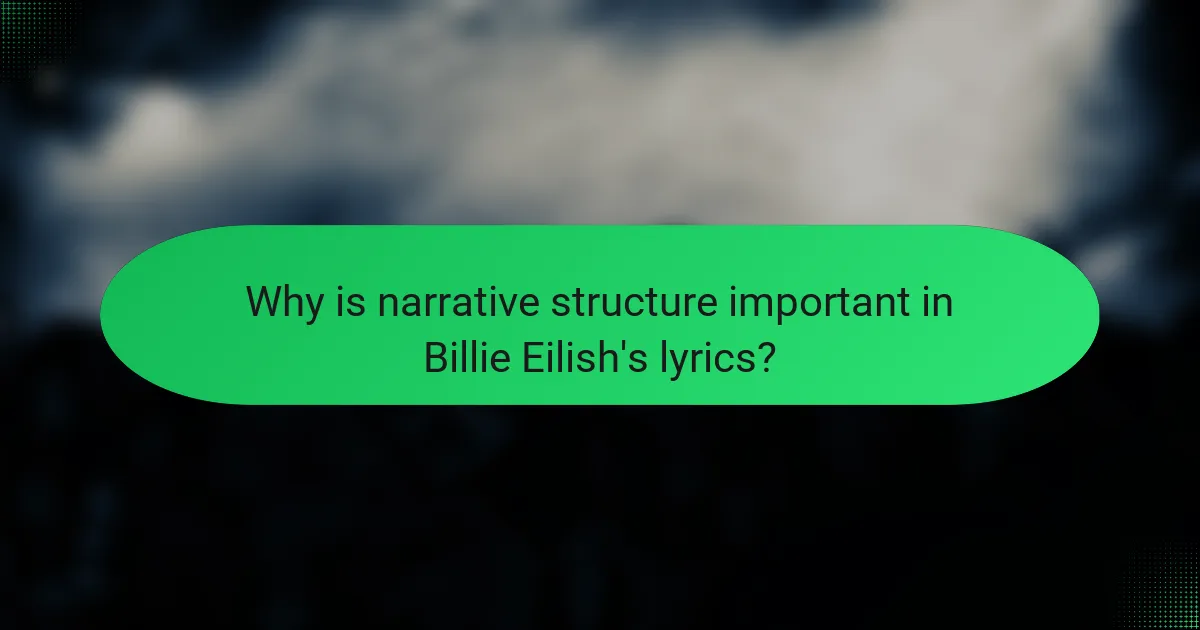
Why is narrative structure important in Billie Eilish’s lyrics?
Narrative structure is important in Billie Eilish’s lyrics because it enhances storytelling and emotional engagement. Eilish often uses a clear beginning, middle, and end in her songs. This structure allows listeners to connect with the characters and themes she presents. For example, in “When the Party’s Over,” the narrative builds tension through vivid imagery and personal reflection. The use of narrative also makes her messages more relatable and impactful. By weaving personal experiences into her lyrics, Eilish creates a sense of authenticity. This connection resonates deeply with her audience and contributes to her widespread popularity.
How does narrative structure affect listener engagement?
Narrative structure significantly influences listener engagement by shaping how stories are perceived. A well-defined narrative structure creates a clear path for listeners to follow. This clarity helps maintain interest and emotional connection. Elements like exposition, climax, and resolution guide the audience through the experience. Research indicates that stories with strong narrative arcs are more memorable. For instance, a study by Green and Brock (2000) found that narrative transportation enhances engagement. When listeners can visualize and emotionally relate to a story, they are more likely to stay engaged. Thus, effective narrative structures enhance the overall impact of the lyrics.
What emotional responses do her narratives evoke?
Billie Eilish’s narratives evoke a range of emotional responses, including sadness, anxiety, and introspection. Her lyrics often explore themes of vulnerability and existential dread. This emotional depth resonates with listeners who relate to her experiences. Eilish’s use of vivid imagery enhances the emotional impact of her narratives. For instance, her song “When the Party’s Over” elicits feelings of heartbreak and melancholy. The raw honesty in her storytelling creates a strong connection with her audience. Research shows that music with relatable themes can evoke powerful emotional reactions in listeners. Therefore, Eilish’s narratives successfully engage her audience on multiple emotional levels.
How does the narrative structure contribute to the overall message of her songs?
The narrative structure in Billie Eilish’s songs enhances the overall message by creating emotional depth. This structure often features a progression of events that reflect personal experiences. Eilish uses vivid imagery and relatable scenarios to connect with listeners. Each song typically follows a clear arc, from exposition to resolution. This allows her to convey complex emotions effectively. For example, “When the Party’s Over” illustrates vulnerability through its narrative flow. The structure emphasizes themes of heartbreak and introspection. By crafting stories within her lyrics, Eilish invites listeners to engage deeply with her message.
In what ways does Billie Eilish’s narrative style differ from other artists?
Billie Eilish’s narrative style differs from other artists through its intimate, confessional tone and vivid imagery. She often explores themes of mental health, vulnerability, and personal experiences. Eilish employs a conversational style, making her lyrics relatable and accessible. Her use of metaphor and symbolism adds depth to her storytelling. Unlike many artists, she frequently incorporates elements of darkness and introspection. This unique approach resonates with a younger audience seeking authenticity. Eilish’s collaboration with her brother Finneas also shapes her distinct sound and narrative perspective. Their synergy results in a cohesive blend of music and storytelling that sets her apart.
What unique techniques does she employ in her storytelling?
Billie Eilish employs several unique techniques in her storytelling. She often uses vivid imagery to create emotional connections. Her lyrics frequently incorporate personal anecdotes, making them relatable. Eilish utilizes unconventional narrative structures that defy traditional song formats. She blends multiple perspectives within a single song to enhance depth. Additionally, she employs contrasting tones to evoke complex emotions. Her use of silence and pauses adds dramatic effect. Eilish’s storytelling is marked by a raw authenticity that resonates with listeners. These techniques contribute to the distinctiveness of her narrative style.
How does her perspective shape the narrative in comparison to her peers?
Billie Eilish’s perspective shapes the narrative by emphasizing vulnerability and introspection. Her lyrics often reflect personal experiences and emotions, creating a deep connection with listeners. In contrast, her peers may focus on broader themes or more polished imagery. Eilish’s raw honesty stands out, making her narratives more relatable. This approach allows her to explore complex feelings like anxiety and loneliness. For instance, in songs like “Bellyache,” she tells a story of guilt and conflict, which resonates with many. Her unique perspective fosters authenticity, distinguishing her work in the music industry.
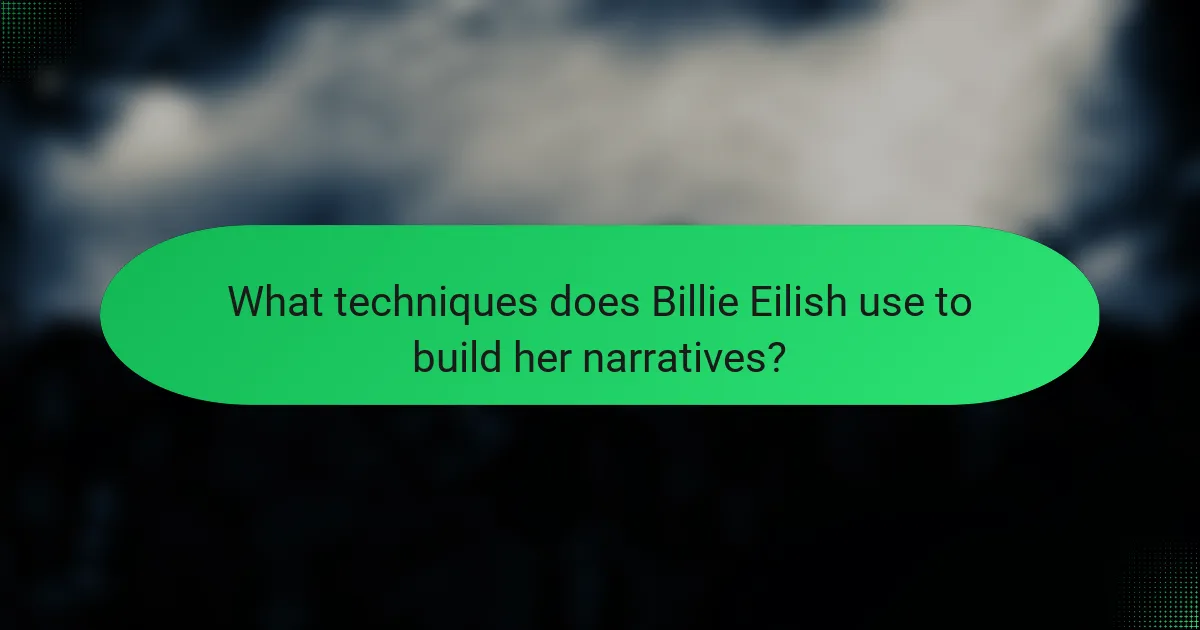
What techniques does Billie Eilish use to build her narratives?
Billie Eilish uses several techniques to build her narratives. She employs vivid imagery to create emotional landscapes. Her lyrics often include personal anecdotes, making the stories relatable. Eilish frequently utilizes first-person perspective, enhancing intimacy with listeners. She incorporates metaphor and simile to deepen meaning. The use of conversational language makes her narratives accessible. Eilish also employs repetition for emphasis on key themes. Her songs often feature unresolved tension, inviting listener interpretation. These techniques contribute to the depth and impact of her storytelling.
How does she incorporate imagery and symbolism in her lyrics?
Billie Eilish incorporates imagery and symbolism in her lyrics by using vivid descriptions and metaphorical language. Her lyrics often evoke strong visual elements that create a specific atmosphere. For instance, she employs contrasting images to depict emotions and experiences. Eilish frequently uses nature-related symbols, such as darkness and light, to represent internal struggles. This approach allows listeners to connect with her themes on a deeper level. Additionally, her use of personal anecdotes serves as symbolic representations of broader issues, enhancing relatability. The combination of these techniques creates a rich narrative that resonates with her audience.
What specific examples illustrate her use of vivid imagery?
Billie Eilish employs vivid imagery in her song lyrics through specific examples. In “when the party’s over,” she describes a glass of water as “cold and empty,” evoking a sense of isolation. In “bury a friend,” she uses the phrase “running to the bathroom” to illustrate panic and urgency. Additionally, in “ocean eyes,” she paints a picture of “blue eyes like the ocean,” creating a strong visual connection. These examples showcase her ability to evoke emotions and imagery through precise language.
How does symbolism enhance the depth of her narratives?
Symbolism enhances the depth of Billie Eilish’s narratives by adding layers of meaning. It allows listeners to interpret her lyrics on multiple levels. For example, recurring motifs like darkness and water symbolize emotional struggles and vulnerability. These symbols evoke strong imagery and resonate with personal experiences. Eilish’s use of symbolism invites audience engagement and reflection. It transforms simple lyrics into profound statements about life and identity. This depth is evident in songs like “When the Party’s Over,” where the glass symbolizes heartbreak. Such elements create a rich tapestry of emotions, making her narratives more impactful.
What role does tone play in her narrative structure?
Tone significantly shapes the narrative structure in Billie Eilish’s song lyrics. It establishes the emotional context and guides the listener’s interpretation. Eilish often employs a melancholic tone, which enhances themes of vulnerability and introspection. This tone creates a connection between her experiences and those of her audience. For example, in songs like “When the Party’s Over,” the somber tone underscores feelings of heartbreak and isolation. The consistent use of tone allows for a cohesive narrative flow throughout her discography. Thus, tone plays a crucial role in conveying the depth of her lyrical storytelling.
How does the tone shift throughout her songs?
Billie Eilish’s songs exhibit a dynamic shift in tone, reflecting a range of emotions. Her lyrics transition from dark and introspective to bright and hopeful. For instance, in “Bellyache,” the tone is remorseful and contemplative. Conversely, in “Happier Than Ever,” the tone evolves to a more assertive and liberated expression. This tonal variation enhances the narrative depth of her music. Eilish often employs contrasting imagery to emphasize these shifts. The emotional spectrum allows listeners to connect with her experiences on multiple levels. The tone shifts serve to mirror personal growth and self-reflection in her storytelling.
What impact does tone have on the listener’s interpretation of her narratives?
Tone significantly influences the listener’s interpretation of narratives. It shapes emotional responses and affects how messages are received. For instance, a somber tone can evoke feelings of sadness or empathy. Conversely, an upbeat tone may create a sense of joy or hope. Billie Eilish often employs varied tones to enhance her storytelling. This use of tone helps listeners connect with the themes and emotions in her lyrics. Research shows that tone can alter perceptions of intent and meaning in communication. Thus, the tone in Eilish’s narratives plays a crucial role in shaping listener engagement and understanding.
What are some practical tips for analyzing the narrative structure in her lyrics?
To analyze the narrative structure in Billie Eilish’s lyrics, focus on identifying key elements such as characters, setting, and plot progression. Examine the emotional tone and perspective in her storytelling. Look for recurring themes and motifs that contribute to the narrative arc. Pay attention to the use of imagery and metaphors, as they enhance the storytelling. Analyze the song’s structure, including verses, choruses, and bridges, to understand how they support the narrative flow. Consider the context of the lyrics within her discography for deeper insights. These techniques can reveal the complexities of her lyrical storytelling.
How can listeners identify key narrative elements in her songs?
Listeners can identify key narrative elements in Billie Eilish’s songs by analyzing her lyrics for themes and storytelling techniques. Her songs often feature vivid imagery and emotional depth. Eilish frequently uses personal experiences to shape her narratives. She incorporates relatable characters and situations that resonate with her audience. The use of specific language and metaphors enhances the storytelling aspect. Additionally, the structure of her songs often follows a clear progression. This includes setups, conflicts, and resolutions that mirror traditional storytelling. By focusing on these aspects, listeners can uncover the narrative layers within her music.
What resources are available for deeper analysis of her lyrical narratives?
Scholarly articles and books provide resources for deeper analysis of Billie Eilish’s lyrical narratives. Academic journals such as “Music and the Moving Image” often publish analyses of contemporary music lyrics. Books like “Billie Eilish: The Unofficial Biography” by Ellie McDonald explore her songwriting style. Additionally, websites like Genius offer annotated lyrics that break down themes and narratives. Documentaries and interviews also provide insights into her creative process. Online forums and fan discussions can reveal interpretations and analyses shared by listeners. These resources collectively enhance understanding of the narrative structure in her lyrics.
The main entity of this article is the narrative structure in Billie Eilish’s song lyrics. The article explores how Eilish employs character development, conflict, and resolution to create emotionally engaging narratives that resonate with listeners. It highlights common themes such as mental health, heartbreak, and self-identity, while also examining the techniques she uses, including vivid imagery, symbolism, and tone. Additionally, the article discusses how her personal experiences influence her storytelling and the overall impact of her narrative style on audience engagement.
